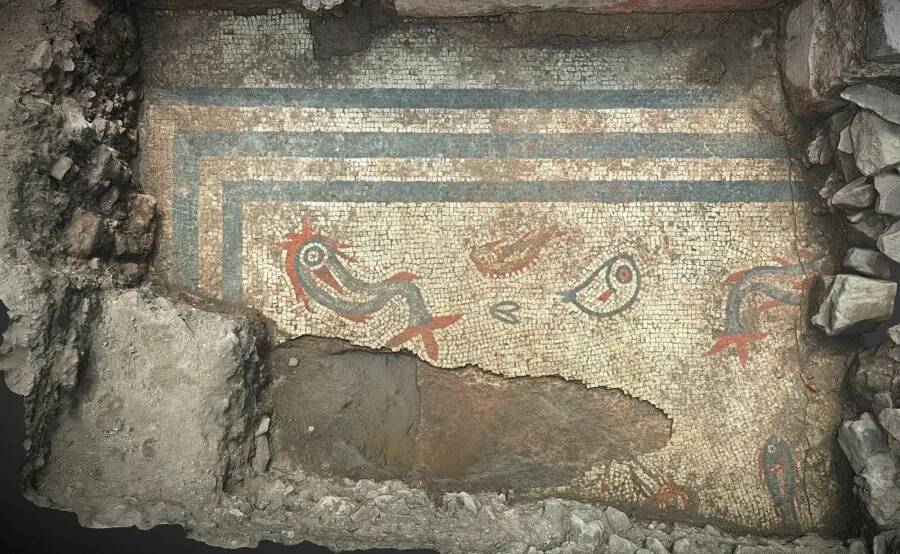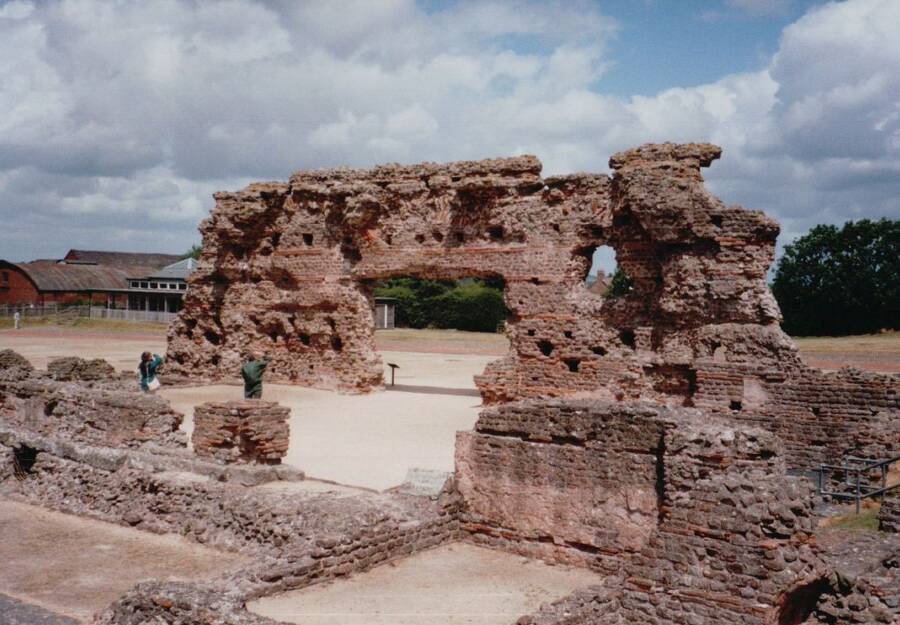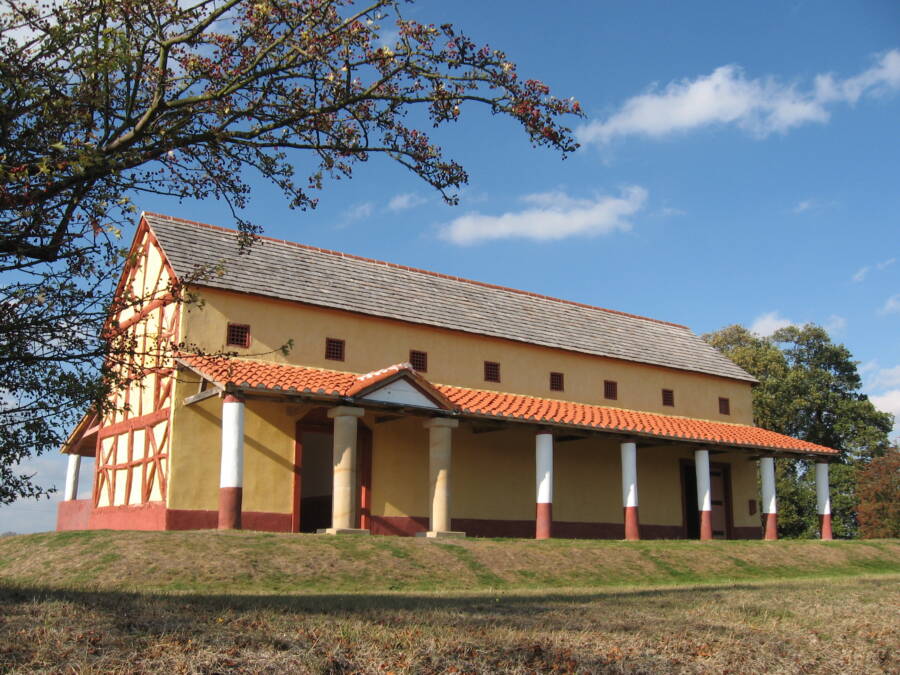While searching for the walls of an ancient Roman building in Wroxeter, England, archaeologists happened upon this 2,000-year-old mosaic featuring brightly-colored marine life in a rare aquatic tableau.

English HeritageArchaeologists believe this mosaic was commissioned by a “wealthy and important person” that used it to adorn the dining room of their lavish townhouse.
Archaeologists have long known that Wroxeter Roman City, once one of the largest cities in Roman Britain, holds a wealth of historical treasures. Even still, researchers were recently surprised to uncover a 2,000-year-old mosaic featuring vivid depictions of marine life while they were in the middle of a search for the city’s main civic temple.
The stunning mosaic, well-preserved thanks to later additions on top of it, speaks to the “wealth and confidence” of Wroxeter Roman City, which was once known as Viroconium Cornoviorum. In the words of archaeologist Win Scutt, “It’s always an astonishing moment when you uncover a fragment of beauty hiding just below the ground.”
‘A 2,000-Year-Old Aquarium Frozen In Stone’: The Dolphin And Fish Mosaic Unearthed In Wroxeter Roman City

English HeritageAn archaeologist at work examining the dolphin and fish mosaic discovered at Wroxeter Roman City.
According to a statement from English Heritage — which partnered with Historic England, the University of Birmingham, Vianova Archaeology & Heritage Services, and Albion Archaeology to make the discovery — the Roman mosaic was discovered during recent excavations in Wroxeter.
Even after the wealth of archaeological finds previously made in the ancient Roman city, this mosaic still came as a surprise. According to Vianova Archaeology, archaeologists were actually searching for the walls of an elusive civic building when they stumbled upon the 2,000-year-old mosaic.
“We’d been digging for days through thick layers of building debris at one end of the trench and I was beginning to think we wouldn’t find anything of interest below it,” Dr.Peter Guest of Vianova Archaeology, who directed the excavation, told All That’s Interesting in an email. “So I was very surprised when my co-director, Mike Luke, came up to me in another trench where I was working to tell me I needed to come and see something ‘very special’.”
Guest continued: “The students digging in the trench, Andrew and Mikey, then showed us a small patch of the mosaic they had just revealed and it was immediately clear that it was in excellent condition and that it was decorated – we could already see the tail of one of the dolphins! We uncovered the full extent of the mosaic in the trench over the next couple of days and it was fantastic to watch it being exposed and cleaned.”
Using bright shades of red, white, blue, and yellow, the mosaic depicts fish and dolphins in a striking tableau of marine life, the likes of which aren’t often seen in similar works from the period. It’s the first mosaic to be found in Wroxeter since 1859 and the “first figurative mosaic ever from the city.”

Vianova ArchaeologyThe mosaic, though 2,000 years old, was uncovered in surprisingly good condition.
Archaeologists believe that the mosaic dates back to the second century C.E., and that it was commissioned by “a wealthy and important person” who lived in a townhouse in the Roman city. The mosaic likely survived because the building was later remodeled, probably in the third or fourth century, and the mosaic room was filled with debris to elevate the structure.
“That might seem surprising to us today, but the building and the mosaic might have been 200 years old by that point and perhaps there were structural problems, or the inhabitants didn’t need that part of the house any more?” Guest remarked to All That’s Interesting.
According to English Heritage, the mosaic “speaks to the wealth and confidence of the founders of the city, even in its earliest years.” Indeed, Viroconium Cornoviorum has a long and colorful history.
The Rise And Fall Of Viroconium Cornoviorum

Wikimedia CommonsThe ruins of Wroxeter Roman City, also known as Viroconium Cornoviorum, once a thriving city in Roman Britain.
Viroconium Cornoviorum, located today near the village of Wroxeter in Shropshire, England, was established in the first century C.E. as a mere frontier post. It was strategically located near a major Roman highway, Watling Street, and acted as a defense against Cambria (Wales).
Before long, however, this Roman frontier post grew into a thriving city.
The Roman city came to be the fourth largest settlement in Roman Britain, and boasted a population of more than 15,000 people. Stretching across 173 acres, Viroconium came to include a forum, a basilica, temples, and shops. The city outlasted the fall of the Roman Empire, which fell in the West in 476 C.E., but eventually descended into ruin and was abandoned by the seventh or eighth century.

Chris Andrews/Replica Roman Villa, Wroxeter/Wikimedia CommonsA recreation of a Roman townhouse in Viroconium. The dolphin mosaic was likely placed in a townhouse like this.
It’s long been a rich site of archaeological discoveries from the Roman era, but this dolphin and fish mosaic is an especially thrilling find. According to Guest it provides “fascinating insight into town life in this part of early Roman Britain.” While it’s unclear if the people who commissioned the mosaic were “Romans or romanised Britons” it’s clear they “could afford to express themselves in very Roman ways.”
“The mosaic is a truly lovely thing and it was a joy to watch it being uncovered and cleaned,” Guest remarked in the Vianova Archaeology statement, “like looking at a 2,000 year-old aquarium frozen in stone!”
After reading about the dolphin and fish mosaic that was unearthed in Wroxeter Roman City, discover the story of the Picts, the fierce Scottish warriors who held off the Romans. Then, learn about the Druids, the mysterious Celtic priests documented by Romans like Julius Caesar.





